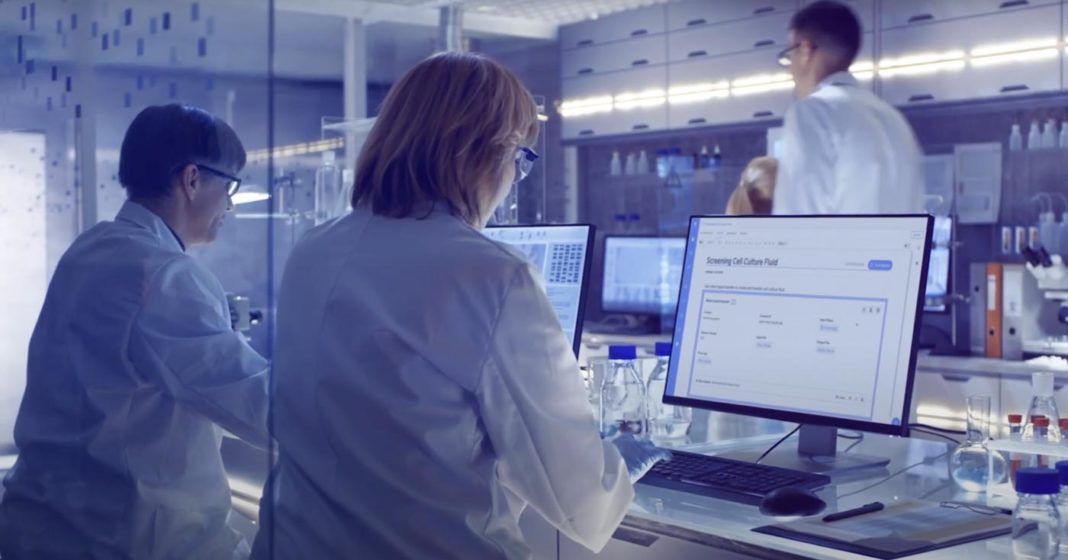Benchling is a next-gen laboratory informatics platform that is helping life science companies manage increasingly complex data workflows. GEN Edge talks to CEO/co-founder Saji Wickramasekara and Michael Schwartz, Head of Product Marketing.
Benchling is a new breed of Laboratory Information Management System (LIMS) platform helping academic research groups, biopharmas and other life science companies manage their data in the cloud. The Silicon Valley company was founded in 2012 by Saji Wickramasekara and Ashu Singhal. Both had backgrounds in software engineering and computer science, along with wet lab experience. Singhal had applied to MD PhD programs but decided that building tools for the industry was actually his calling. Similarly, Wickramasekara felt he could make a bigger contribution applying his software engineering skills and leaving the bench, so to speak.
In this interview, GEN’s Kevin Davies spoke to Benchling CEO Saji Wickramasekara and head of product marketing, Michael Schwartz. The discussion explores the client needs that Benchling strives to fill and the company’s mission and future plans. (The interview has been lightly edited for length and clarity.)
GEN EDGE: Saji, how did you launch Benchling?
 Saji Wickramasekara: I’m actually a software engineer by training, not a scientist per se, but I spent a few years in molecular biology wet labs doing basic academic research. I was very interested in the design and development of medicines and thought I was going to pursue a career in biotech. I was ready to go to grad school for my PhD. Ultimately, I didn’t do that…
Saji Wickramasekara: I’m actually a software engineer by training, not a scientist per se, but I spent a few years in molecular biology wet labs doing basic academic research. I was very interested in the design and development of medicines and thought I was going to pursue a career in biotech. I was ready to go to grad school for my PhD. Ultimately, I didn’t do that…
In software, it’s much easier to work with other people. You have really great tools for collaboration around fairly complex work. If I compared that to the life sciences, everything was running on paper, email, and spreadsheets! It was very challenging to work with others on increasingly complex work.
I founded Benchling to scratch that itch and to build tools that I would have liked to use as a lab scientist—build to the point where I’d be excited to do scientific research again! We initially built this product for academic scientists as more of a productivity tool, but as we took it to industry, we found there was a greater need there. That was facilitated by the shift from chemistry to biology and the complexity of the work.
A couple of things happened: There were major transformations in science. Today, eight of the top 10 drugs are biologics, and the first generation of CAR-T cell therapies have been introduced. We have CRISPR! The complexity of the work is very different. From a data management perspective, that’s a totally different data model and different set of processes.
All of a sudden, you have this exponential growth and complexity of work that scientists are trying to do, but the tools are still paper and spreadsheets! They just had not evolved. There was a huge need in industry as well and innovation really grew from there.
GEN Edge: Michael, how did you arrive at the company?
 Michael Schwartz: I’ve been at Benchling for a year leading product marketing. I started off as a bioengineer, doing medical devices. I co-founded a company that was doing cellular analyses – I even wrote an article for GEN about nine years ago!
Michael Schwartz: I’ve been at Benchling for a year leading product marketing. I started off as a bioengineer, doing medical devices. I co-founded a company that was doing cellular analyses – I even wrote an article for GEN about nine years ago!
As a bio-engineer, I was looking to have the greatest impact on the world. Life sciences was great, but I got turned on to this world of software. We’d observed these massive transformations in other industries, living in Silicon Valley and San Francisco.
I moved into software-as-a-service about five years ago, leading the life science vertical at Salesforce. Saji really impressed me, not just for the company but with the mission of the company. I’d seen software transform the commercial and medical sides of the pharmaceutical industry, even clinical development. But R&D was this final frontier. If you think about where great medicines are discovered and developed, it’s upstream, but the software landscape here was the most fragmented.
GEN Edge: Saji did you have any previous company experience or was this literally going from academia to CEO?
Wickramasekara: Yes, it was. But in the beginning, you’re just the CEO of you and another person, and it’s not too big a change. Initially I got into this to scratch a personal itch. The company part came later. As a software engineer, I wanted to build tools that I thought should exist. It turned out there was a market for those tools and here we are.
GEN Edge: Has your main focus evolved away from academia?
Wickramasekara: It wasn’t necessarily just to serve the academic market so much that it was a great place to start, and to make sure that what you were building was loved by scientists, doing cutting-edge biology, working with CRISPR.
Today, we’re a business, we have a pretty ambitious set of products to build and the majority of our paying customers are in industry—cutting-edge biotech upstarts like Beam Therapeutics, Prime Medicine, Verve Therapeutics, Mammoth Biosciences, Editas Medicine. And big pharma companies as well, such as Gilead and Regeneron. I spend a lot of time in Westchester County!
GEN Edge: How is Benchling different than any other LIMS — Lab Information Management System—company. Can I even bracket you in that category?
Wickramasekara: The first generation of those electronic lab notebook [ELN] and LIMS companies was focused on the paper-to-glass transformation. The science wasn’t as complex back then, so you didn’t need as flexible a system. Those workflows were fairly rigid and so we transplanted that over and said let’s make it digital.
When that first evolution happened, 10–15–20 years ago, patents were awarded “first to discover,” not “first to file”. So there was also a compliance tailwind, not a scientific complexity tailwind that we’re experiencing now. But today, R&D teams are much more sophisticated and thinking very holistically. They want their data and processes completely connected through their applications.
They want the data structured and searchable, running large distributed organizations with highly specialized teams and lots of handoffs. The stakes are just so much higher. We’re the next generation of those ELN and LIMS companies of the past.
GEN Edge: Where are you seeing the most activity and growth? Is it in biotech and pharma or are you moving into other areas?
Wickramasekara: We’ve seen dramatic adoption throughout the industry both in the development of medicines, but also outside medicine. We have customers in industrial biotechnology, agricultural biotechnology, and food science—cultured meats and dairy replacements and other industrial applications. They have similar needs to biopharma with many shared R&D functions between them.
GEN Edge: What are some of the new features on the platform that you’ve added in the last year, or that are coming out in 2021?
Schwartz: Yes, a lot. We’re quite proud of the product and engineering teams because this was the model that Saji and Ashu set up. It’s not just SaaS, but it’s a continual innovation model. We’re able to pump new features, literally every week, whereas a lot of the legacy systems got stuck in these annual updates that were a hassle really for customers.
Wickramasekara: Frankly, the science moves too fast to do an annual update anymore. Take CRISPR—there’s a new base editor like every week!
Schwartz: Some of the bigger things we’ve introduced in the last few months include a lab automation element. Now almost all our customers have analytical instruments and liquid handlers that power the throughput of their labs. These are more like out of the box integrations to bake those right into the workflow.
We added an application called Insights—embedded intelligence right in the application. Previously, most of our customers would get a bunch of data and pump it out into Excel or a business intelligence tool. That still serves a purpose in some instances. But having online insights that contextualize all the way back to the sequence or the cell line is the preferred way for most of the biotechnology industry.
GEN Edge: What are your top success stories? What organizational problems have you really been able to help solve?
Wickramasekara: There are hundreds of organizations listed on our website. Obviously, we work with household pharma companies—Regeneron, Gilead, etc.—they have many medicines in the market. Many smaller biotech companies grew up with us from the beginning and have gone from five people to ten scientists to hundreds of scientists and now have their first medicines in clinical trials. All credit to them for building the medicines, but we were the enabling tool and foundational infrastructure for them. That’s something we’re really proud of.
GEN Edge: What problems has COVID-19 caused for your customers and how have you and they adapted?
Wickramasekara: Two things to discuss. First, we’re seeing a dramatic acceleration in the business, especially from large research organizations who need to adopt much more bleeding edge collaborative tools. Two or three years of digital transformation initiatives are being pulled into three months, sometimes things are moving at breakneck speed which is not something we’ve experienced in the past. The old on-premise tools that aren’t built for collaboration just aren’t cutting it when you have scientists taking shifts in the lab and having to work from home. We’re seeing an acceleration there.
Benchling is software that scientists already use all day. But we’re still seeing in some companies, especially those working on the front lines of COVID, usage jumping about 30%. They’re doing nights and weekends and we’re having to be on call 24/7 for some of these companies working on COVID antibodies and vaccines, because nothing can go wrong for them. It’s been awesome to be part of that. Again, they’re the ones doing the hard work, we’re not trying to take credit here. But we’re really happy to support those efforts.
In addition, we’ve found a new growth market in clinical testing. It’s not something we’d really been a part of before, but we wanted to do what we could to help with testing capacity, which is a general constraint in many countries. We’re working with more than a dozen labs in different countries, different states. We’re processing hundreds of thousands of tests per month because our software is a transformative tool to have when you’re spinning up a new lab or repurposing an old research lab. Corteva Agriscience is one of the largest agricultural companies in the world. They have a partnership with their local health system Mercy One, and we’re the software powering that.
You still need to ingest samples, barcode, track them through the process, run assays, capture the data from instruments, and report the results back. If you need to get that up and running in a week, there aren’t a lot of answers except something like Benchling. Normally it takes six months to roll out a system like that.
GEN Edge: Data security and reproducibility is an ongoing concern. Does Benchling help groups in academia and industry establish the provenance and the authenticity of their primary data?
Wickramasekara: Yes, absolutely. That’s one of the whole premises of a modern cloud solution like Benchling—you know who did what, you’ve done your best to not only standardize data but automate the capture of it. So you’re even removing humans from the equation where there’s normally a surface area for manual errors to be made.
This is something I’m very sensitive to, coming from academia. Data integrity and the duplication of work are serious problems in science. In industry, you often hear about a drug being put on hold because in some animal study there was an error copying the data. When you have electronic systems instead of paper, you’re eliminating most of those errors.
Back when I was doing research at Duke University, the lab next door to mine had a huge reproducibility crisis, papers were getting retracted because clinical trials were starting off that [research]. So I’ve seen firsthand how damaging that can be. The solution is to build tools so good that scientists want to use them. If they’re using those digital tools, you can solve these reproducibility and data integrity issues.
GEN Edge: You mentioned a few bellwether CRISPR companies among your clients. What is it about CRISPR that Benchling is proving so helpful?
Wickramasekara: There are a couple of reasons. At the macro level, these companies are doing really complex science that’s never been done before. They need some way to track all the different cell lines, proteins, plasmids, CRISPR guides and link all them together to have full experimental context so they can keep moving quickly.
Those organizations are early adopters of tools like ours—we’ve been working with Jennifer Doudna, Feng Zhang’s lab, George Church, David Liu, and others, they were some of our first adopters. They were the voices in our ear telling us, “you need to build these capabilities”. CRISPR was by design—it’s a hard computational problem doing a full genome search and scoring these guides very rapidly. Prior to Benchling, the solution was a freeware tool, run by a grad student, which would take you 8–10 hours to get your results back. We do it in a couple of seconds.
GEN Edge: What are you most excited for over the next 12 months, besides the pandemic winding down, hopefully?
Schwartz: I’m excited for our push downstream to connect the dots across a wider swath of R&D. Our customers are building platforms, the centers of excellence, which continues all the way through the R&D process. We have some exciting announcements coming up next year that will directly support that well.
Wickramasekara: We’re becoming a global company. That’s really exciting to me. We’re making a big push into Europe right now. Many of our customers are multinationals, with sites in the U.S. and Europe, Asia as well. Becoming a global company is the next big milestone.
Schwartz: Saji might be too modest to talk about this, but at Benchling, the mission is focused on helping companies build better therapies in the world. He’s also built a company that’s trying to do good in the world. Our people are helping support STEM causes. We’re also trying to empower scientists to do better in the academic world and volunteering in the communities we live in. I know that’s something that makes me enjoy coming virtually to work every day.
Wickramasekara: Yes, all the COVID testing work is pro bono. We’re giving away the testing platform that is helping all these labs and communities do their COVID testing. That’s really important to us.


